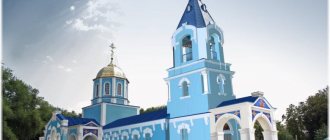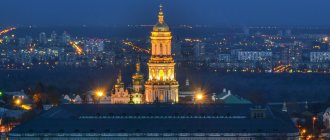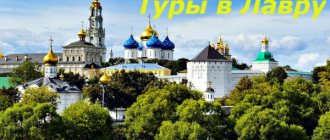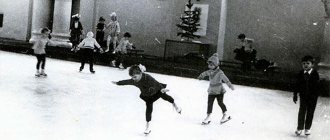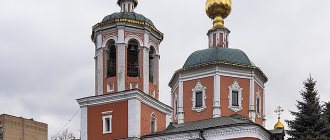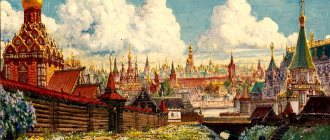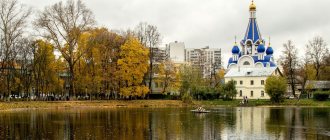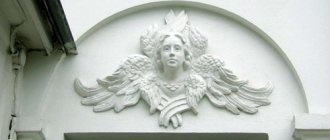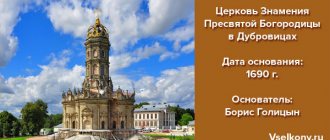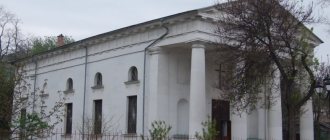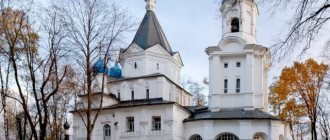The glorious history of the Assumption Church
On the present site of the temple in 1721, a monastery courtyard with a small church and several buildings was founded. During its history, it passed from one monastery to another several times. In 1875, it was acquired by the Kiev Pechersk Lavra.
At that time, the small church could not accommodate all the parishioners, and the buildings around did not meet the requirements of a monastic compound. Metropolitan Ioannikiy of Kiev petitioned for the reconstruction of the metochion. And in 1894, a competition was held among architects to build a complex of church buildings. Among the many works, the project of Vasily Antonovich Kosyakov was selected. In his project, he managed to give the building solidity and simplicity, to combine the comfort of a home church with the grandeur of a metropolitan cathedral.
The building is made in pseudo-Russian style. The lower part of the building is finished with gray granite. The top is built of Radom sandstone and fourteen types of molded bricks. To make the interior of the temple as spacious as possible, the architect proposed an original solution - intersecting arches. Thus, he managed to arrange the interior of the church without columns, and the hall for conducting services turned out to be huge; it could accommodate up to two thousand parishioners.
In addition to the church, stables, residential, household and service premises were built on the courtyard, and a cozy garden was laid out. The buildings were located in such a way as to protect the peaceful monastic life from the capital city.
On December 18, 1897, the main chapel was consecrated in honor of the Dormition of the Blessed Virgin Mary. And a day later, a side chapel dedicated to Anthony and Theodosius of Pechersk was consecrated.
By 1900, construction was completed. Until 1903, painting of the interior of the temple was carried out by artists from the workshop of Fyodor Sokolov. Researchers claim that Viktor Vasnetsov also had a hand in painting the walls.
Saint Petersburg. Cathedral of the Assumption of the Blessed Virgin Mary.
Cathedral of the Savior on Sennaya
The Church of the Dormition of the Blessed Virgin Mary was located on Sadovaya Street on Sennaya Square (from 1952 to 1991, Peace Square) and was one of the most visited churches in the city. The people also called the church Spas-on-Sennaya or Spaso-Sennovskaya. This widely used name was due to the fact that before the construction of the Assumption Church, in its place there was an older temple in the name of Christ the Savior, namely “in the name of the all-merciful Savior of the origin of the Honest Trees of the honorable life-giving Cross of Christ,” which is celebrated on August 1. Initially, this small wooden temple stood on the Vyborg side, from where it was moved to Sennaya Square. On July 20, 1753, a stone church was founded next to the wooden one, which was built mainly at the expense of the merchant Savva Yakovlevich Yakovlev. Construction lasted 12 years.
The wooden church, located next to the stone cathedral, was dismantled before its construction was completed, in 1761. In the same year, the remains of Savva Yakovlev’s parents were transferred from the Sampsonievskoe cemetery on the Vyborg side to the crypt of the temple that was still under construction (in the chapel of the Three Saints). Externally, the temple was completed in 1762, the year of the accession to the throne of Empress Catherine II. A high three-tier bell tower was erected next to the five-domed stone church. On October 20, 1764, the chapel of St. Savva the sanctified, heavenly patron of the temple builder. On December 5, 1765, the main temple in the name of the Dormition of the Mother of God was consecrated. The iconostasis of the central chapel was painted by the famous icon painter M.L. Kolokolnikov.
The magnificent five-domed church, built in connection with the bell tower, became the dominant feature of Sennaya Square. Its height to the cross of the main dome was 23 fathoms 2 arshins (about 50 meters). In appearance, the temple was somewhat reminiscent of Rastrelli's style, so the alleged authorship of Rastrelli is noted by many researchers, but Andrei Kvasov is also called the author of the temple project.
The temple building was repeatedly reconstructed. In 1816-1817 the architect Luigi Rusca added 2 chapels to the church on the south and north sides. During these years, he rebuilt the portal of the Church of the Assumption from the side of the bell tower (due to uneven settlement of the soil, the bell tower was damaged, and the architect had to rebuild it and connect the warm and cold temples together). In 1833-1836. A.I. Melnikov expanded the temple, rebuilt the domes and vaults. The Spassky and Mikhailo-Arkhangelsky chapels were also rebuilt. The third tier of the bell tower was also rebuilt during these years. The bell tower acquired a more slender silhouette.
There were 15 bells on the bell tower of the Spaso-Sennovskaya Church. On the largest of them, in addition to the depiction of patronal feasts, there was a portrait of Empress Catherine II with the inscription: “Assessor Savva Yakovlev in the Church of the Assumption of the Blessed Virgin Mary, which is on Sennaya, weighing 542 pounds 18 pounds, 1780 January 20 days, lit in Moscow, at the factory Jason Strugovshchikov." The next in weight were: the Mother of God bell - 1780, weighing 274 pounds 26 pounds; polyeleous - 140 poods; everyday - 78 pounds 32 pounds, ancient - 1762, 52 pounds 25 pounds, as well as small bells.
In 1867-1871. The temple was rebuilt again according to the design of the St. Petersburg diocesan architect G.I. Karpova. Under him, a major remodeling of the top of the temple and the bell tower began: the wooden structures were replaced with brick ones, the shape of the domes was slightly changed and the porticos were redone. The stucco work was carried out by Sylvester Kosolapov and Ivan Balin, the painting and restoration of the icons was carried out by Academician. V.V. Vasiliev. The restoration of the temple took four years. All five thrones were removed from their places, and therefore the consecration of each of them was complete.
Perestroika 1867-1871 was the last, after which the temple was no longer rebuilt, maintaining its appearance until the 1960s. At the same time, on the site of the church garden, a four-story building for the clergy of the Spaso-Sennovskaya Church was built (the modern address is Sadovaya, building 40).
In 1897-1898 architect V.V. Windelbandt added concrete vestibules to the temple, and the domes were upholstered in gilded copper. In 1902-1903 The side chapels were lengthened (architect I.I. Yakovlev), repairs and restoration of the images were carried out.
In 1901-1904. porches were added to the temple, in which chapels were placed in the name of Sava the Sanctified and in the name of the Three Saints. Despite repeated reconstructions, the temple retained the charm of a magnificent Elizabethan building in the high baroque style.
The main shrine of the temple was the temple image of the Dormition of the Mother of God, late 18th century, donated by Savva Yakovlev; altarpiece of the Lord of Hosts, surrounded by cherubim, holding the globe and scepter in his left hand, and blessing with his right hand; the image of Christ the Savior, remarkable in that it was erected by Vologda citizens in thanksgiving to God for the deliverance of Vologda from the pestilence (plague) in 1605; an icon of the holy noble prince Alexander Nevsky in memory of March 1, 1881 - the day of the tragic death of Tsar-Liberator Alexander II at the hands of the “populists”; a large icon of the position of the Lord in the tomb; local icons in the main iconostasis - the Savior and the Mother of God.
A lot of educational and charitable work was carried out in the parish of the temple. There was a parish theological school attached to the church. From the first years of the existence of the Spaso-Sennovsky parish, many widows and orphans were looked after here. In 1871, a charitable society was established at the church, and two years later a charitable society was opened to help poor parishioners. HELL. Vodenikov donated a plot of land behind the temple to the society, and a three-story almshouse for elderly women and a shelter for children were erected on it. For 23 years A.D. Vodenikov was the chairman of the society and donated more than half a million rubles to it during this time. Initially, the almshouse cared for 30 old women, later their number grew to 80, and approximately the same number of children were in the shelter of the Spaso-Sennovskaya Church.
After the revolution, church valuables were confiscated from the Church of the Assumption twice. The silver throne was also confiscated. In 1923, the temple was elevated to the rank of a cathedral. From January 25, 1932 until its closure in April 1938, the temple was a renovationist cathedral. In 1933, eleven of its bells with a total weight of 1200 pounds were handed over to the State Fund and, apparently, were melted down. Temple icons in 1936-1938. transferred to the Transfiguration Cathedral and city museums. In April 1938 the temple was closed. Having survived the years of the siege, despite the fact that the temple was indicated as a landmark for German artillery, it did not survive Khrushchev’s “thaw”.
In January 1961, the temple, from which the roof (gilding and copper) had previously been torn off, was blown up, making way for the construction of a pavilion for the Peace Square metro station (now Sennaya Square). By the way, before the explosion, architect Yu.M. Denisov made measurements of the temple; floor drawings and sections of the church building have been preserved, which can be used to restore the temple.
About the Church of the Dormition of the Blessed Virgin Mary, which stood on Peace Square in Leningrad until February 2, 1961, has already been written many times. There are a huge number of drawings, lithographs and photographs of her. However, the authorship of this temple is a dark question. In appearance, the temple was somewhat reminiscent of Rastrelli's style, so the alleged authorship of Rastrelli is noted by many researchers, but Andrei Kvasov is also called the author of the temple project.
I will not go into details of its construction in 1753, reconstruction and expansion in 1813 according to the design of Luigi Rusca and in 1836 according to the project of A.I. Melnikova. I will only note that the extreme restructuring and superstructure designed by the St. Petersburg diocesan architect G.I. Karpov 1867–1871 was the last, after which the temple was no longer rebuilt, maintaining its appearance until the 1960s.
The idea of building a temple arose among Sennov merchants in 1743, but permission for it came only 8 years later. At first, the merchants bought the wooden Church of the Savior of the Origin of the Honest Trees on the Vyborg side and, having moved it, consecrated it on July 18, 1753 in a new location. After 2 days, Archbishop Sylvester laid the foundation for a stone church, which was built on the land and with the money of the wealthy tax farmer S. Yakovlev. Its author was Andrey Kvasov. The plan and proportions of the structure, the elegance of the installation of the main dome suggest that B.-F. participated in the construction of the church. Rastrelli, who built a rich man’s unpreserved mansion nearby.
According to the original plan, the church was divided into a warm half with two chapels and a single altar cold one. Five years later, the temple was ready, but a commission of architects proposed to redo the vaults in it, which is why the consecration of the first, left, side-chapel of the Three Saints was delayed until June 20, 1761. Yakovlev transferred the remains of his parents from Sampsonievskoe cemetery to the crypt below it. Externally, the church was completed by 1762.
On October 2, 1764, it was the turn of the right aisle in the name of St. Savva the Sanctified, whose name the temple builder bore, and, finally, on December 5, 1765 - the main, cold one, consecrated first in the name of the Presentation of the Lord. Later it was reconsecrated in the name of the Dormition of the Mother of God. The image in this chapel was painted by the famous painter M. L. Kolokolnikov. The majestic and spacious temple was crowned with five domes standing on multifaceted drums. Adjacent to the high refectory was a three-tiered bell tower, ending in a slightly elongated dome. In 1816-1817, the architect L. Ruska slightly remodeled the bell tower, which had been damaged by uneven settlement, and connected the warm and cold churches together. The entrance to the church was decorated with a multi-columned portico with a pediment, the same type as that of the guardhouse standing in the northern corner of the square, erected by the same architect.
In 1833-1835, the architect A.I. Melnikov, while renovating the church, redid the domes and vaults. Even earlier, on January 14, 1822, the chapel he created on the south side of the main altar was consecrated - in the name of the All-Merciful Savior, and later on February 14, 1835 - the northern chapel in the name of Archangel Michael, built by P. F. Votsky. As a result, the building somewhat lost its stylistic unity. In 1867, according to the project of G.I. Karpov, a major remodeling of the top of the temple and the bell tower began: the wooden structures were replaced with brick ones, the shape of the domes was slightly changed and the porticos were redone. First, they renovated the main church, and after its consecration, the small one. All five thrones were removed from their places, so the new consecration of each was complete. Work continued until 1873, although on October 1, 1870, the renovated temple was already consecrated. In 1897-1898, V.V. Windelbandt added concrete vestibules and covered the domes with gilded copper. In 1902-1903, the side chapels of the temple were lengthened according to the design of I. I. Yakovlev, repairs and restoration of the images were carried out. Three years later, the clergyman of this huge and well-attended church asked to raise the temple to the rank of a cathedral, but this rank was received only in 1923.
The high gilded iconostasis of the church in the Baroque style with icons from the mid-18th century was considered one of the best in the capital. In addition to it, in the church there was a magnificent throne from 1786 with a gilded rotunda, decorated with silver bas-reliefs, distinguished by the perfection of artistic embossing and weighing more than 100 kilograms - a donation from the creator of the temple. There were no such altars in any other metropolitan church. The temple builder Yakovlev also donated a shroud made of crimson velvet, embroidered with silver, gold and pearls, for which in 1856 the famous jeweler F.A. Verkhovtsev made a new tomb of silver weighing seven pounds, the model of which was later used for the tomb for St. Isaac's Cathedral. Most of all in the temple, the local image of the Assumption in a gilded silver frame with a chasuble strewn with pearls, a list of the Tikhvin Mother of God from the chapel, which on June 27 was exhibited on the porch for worship, and the image of Christ the Savior, before whom the Vologda community prayed on October 18 in memory of the deliverance in 1605, were revered their cities from the plague. The large icons “Burial of the Savior” and “St. Andrew, Bishop of Crete” brushed by V. M. Peshekhonov, paintings by G. G. Myasoedov. The pride of the temple were also its bells, the incomparable sound of which delighted St. Petersburg residents and guests. Among the fifteen bells, some could easily compare with the best works of Russian artistic casting. The largest of them weighed 542 pounds 18 pounds and was cast in Moscow at the Yason Strugovshchikov plant.
The Assumption Church, better known as “Savior on Sennaya” (after the name of one of the chapels), standing on a large shopping area, was one of the especially visited churches in St. Petersburg. In the 20s of the 19th century there was a parish theological school at the Spaso-Sennovskaya Church. In addition, widows and orphans of clergy were placed in church houses. This church was considered a special shelter for orphans. In December 1871, a Charitable Society was established at the Spaso-Sennovskaya Church to help poor parishioners; it began operating on December 16, 1873. The Society had an almshouse for old women and a shelter for children.
In the 1920s, all valuables from this rich church, despite strong resistance from the parishioners, were confiscated; in April 1938, the temple was closed and removed from security. The older generation of townspeople still remembers this dark green five-domed temple with a high bell tower above the entrance, blown up on a January night in 1961 to make way for a new metro station. The absurdity of this action is still striking: according to a number of experts, the temple in no way interfered with the wretched stall that is the station pavilion, and even speaking about the aesthetic side, the appearance of the city was greatly lost with the disappearance of this ancient monument. Nowadays, in memory of this shrine, a small chapel is being built next to the metro station lobby.
Revolutionary and Soviet years in the life of the courtyard
Services were held daily in the temple, a large library worked, and the monks carried out their obedience within the walls of the monastery. But the revolution of 1917 broke out and the quiet life of the monks and parishioners ceased.
At first the courtyard acquired the status of a parish church. In the 1920s, all valuables were removed from the temple. The authorities have repeatedly attempted to close the church. They wanted to transfer the building to the management, but the transfer did not take place. Later it was decided to demolish the building. Parishioners collected more than three thousand signatures in defense of the temple. The arrest of the monks remaining at the temple and a number of activists from among the parishioners followed. Among those exiled to Solovki was the choir singer Mikhail Vasilyevich Gundyaev, the father of the current Patriarch Kirill.
In 1935, the temple was closed and a warehouse was built in it. In 1961, a skating rink with an artificial ice surface was built here. The priceless paintings on the walls were simply painted over. Exposure to prolonged cold and moisture destroyed the walls and foundation of the historical structure.
Rebirth and revival of the temple
In June 1990, the temple was returned to the Orthodox Church. The commission that assessed the building rendered a verdict that it could not be restored. But it was decided to restore the building to its original form. And already in 1993, services began in the side aisle.
In 1997, work began on restoring the wall paintings, which continues to this day. The iconostasis was installed based on surviving photographs. There are six bells installed on the belfry.
The parish library at the church was one of the first to operate. Today there are more than twenty-two thousand copies in its archive.
In the last year of the twentieth century, the Institute of Religious Studies and Church Arts was opened at the temple. Here everyone can master icon painting, embroidery, church singing, and theology. Later an Orthodox Gymnasium was opened. The male choir is another treasure of the Assumption Compound. The harmonious singing of the choir accompanies every service.
The church has become an island of spiritual life in the very heart of St. Petersburg. Its urban location facilitates its extensive social and educational activities. She carries out active charity work.
List of aisles
The Church of the Blessed Virgin Mary has the largest number of altars in St. Petersburg: there are seven in total. On the lower floor of the temple there are three chapels:
- In the south is the throne of Saints Cyrus and John;
- In the north: the throne of the Intercession of the Blessed Virgin Mary;
- In the main: the throne of the Annunciation of the Blessed Virgin Mary.
The following chapels are located on the top floor of the temple:
- Main: throne of the Exaltation of the Holy Cross;
- In the choir: the throne of the Conception of John the Baptist, the chapel is located in the attic;
- Side: Elijah the Prophet and the Prophet of the Blessed Virgin Mary.
